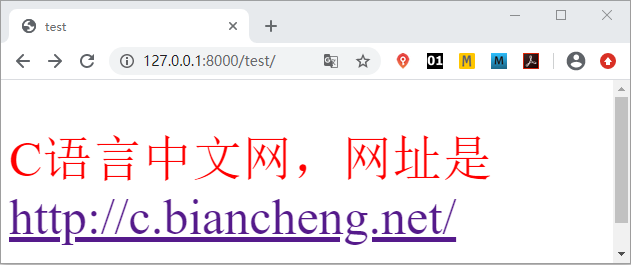Django模板加载与响应
在前文章节《Django模板系统》中,我们对 Django 的模板系统有了初步的认识,在本章我们将重点讲解 Django 的模板语言。
Djano 的模板系统将 Python 代码与 HTML 代码解耦,动态地生成 HTML 页面。Django 项目可以配置一个或多个模板引擎,但是通常使用 Django 的模板系统时,应该首先考虑其内置的后端 DTL(Django Template Language,Django 模板语言。
方式一:通过 loader 获取模板,通过 HttpResponse 进行响应

图1:页面展示效果
rebder() 方法的完整参数格式如下所示:
常见的 content_type 媒体格式,如下所示:
Djano 的模板系统将 Python 代码与 HTML 代码解耦,动态地生成 HTML 页面。Django 项目可以配置一个或多个模板引擎,但是通常使用 Django 的模板系统时,应该首先考虑其内置的后端 DTL(Django Template Language,Django 模板语言。
1. 什么是模板
在 Django 中,模板是可以根据字典数据动态变化的,并且能够根据视图中传递的字典数据动态生成相应的 HTML 网页。Django 中使用 Template 来表示模板,Template 对象定义在 django/template/base.py 文件中,它的构造函数如下所示:def __init__(self,template_string,origin=None,name=None,engine=None)它只有一个必填的参数:字符串表示的模板代码。
1) 模板的配置
首先按照 BookStore/templates路径创建模板文件夹 templates,在 settings.py 配置文件中有一个 TEMPLATES 变量,如下所示:
TEMPLATES = [
{
'BACKEND': 'django.template.backends.django.DjangoTemplates',
'DIRS': [], #指定模板文件的存放路径
'APP_DIRS': True, #搜索APP里面的所有templates目录
'OPTIONS': {
'context_processors': [ #context_processors 用于配置模板上下文处理器
'django.template.context_processors.debug',
'django.template.context_processors.request',
'django.contrib.auth.context_processors.auth',
'django.contrib.messages.context_processors.messages',
],
},
},
]
其中每一项释义如下所示:
- BACKEND : Django默认设置,指定了要是用的模板引擎的 Python 路径;
- DIRS : 一个目录列表,指定模板文件的存放路径,可以是一个或者多个。模板引擎将按照列表中定义的顺序查找模板文件;
- APP_DIRS : 一个布尔值,默认为 Ture。表示会在安装应用中的 templates 目录中搜索所有模板文件;
- OPTIONS : 指定额外的选项,不同的模板引擎有着不同的可选参数,例如 context_processors 用于配置模板上下文处理器,在使 RequestContext 时将看到它们的作用。
2) 修改settings配置文件
修改 settings.py 文件,设置 TEMPLATES 的 DIRS 值来指定模板的搜索目录为“templates”如下所示:'DIRS': [os.path.join(BASE_DIR, 'templates')]
2. 模板的加载与响应方式
那么我们如何加载模板并响应给浏览器呢?在前文《Django模板系统》一文,我们已经介绍了一种 render 的方法,其实这里可以使用的方式主要有两种,在本节我们将更加全面的讲解它们。方式一:通过 loader 获取模板,通过 HttpResponse 进行响应
from django.template import loader
# 1.通过loader加载模板
t = loader.get_template("模板文件名")
# 2.将t转换成HTML字符串
html = t.render(字典数据)
# 3.用响应对象将转换的字符串内容返回给浏览器
return HttpResponse(html)
方式二:使用 render 方法直接加载并响应模板from django.shortcuts import render return render(request,'模板文件名', 字典数据)下面我们对上述两种方式分别来说明:
#方式一
from django.template import loader # 导入loader方法
from django.shortcuts import render #导入render 方法
def test_html(request):
t=loader.get_template('test.html')
html=t.render({'name':'新宝库'})#以字典形式传递数据并生成html
return HttpResponse(html) #以 HttpResponse方式响应html
#方式二
from django.shortcuts import render #导入reder方法
def test_html(request):
return render(request,'test.html',{'name':'新宝库'})#根据字典数据生成动态模板
然后在 templates 目录下创建 test.html 文件并在其中添加如下代码:
<p style="font-size:50px;color:red">{{name}},网址是<a href="https://www.xinbaoku.com/">https://www.xinbaoku.com/</a></p>
提示:{{name}} 属于 django 模板语言的语法,代表一个变量,在后续章节我们会讲解。
最后在 BookStore/urls.py 文件的 urlpatterns 列表中为视图函数 test_html() 配置路由映射关系,如下所示:
urlpatterns = [ path('admin/', admin.site.urls), path('test/',views.test_html), ]
从上述过程我们不难体会 Django 视图函数的实现流程。首先定义了视图函数 test_html(),然后在 templates 文件夹中新建了 test.html 文件,使用它作为模板文件;最后我们配置了视图函数的路由映射关系,以上步骤完成后,我们可以通过访问 127.0.0.1/test 得到如下展示页面:
图1:页面展示效果
3. render方法详解
renbder 方法的作用是结合一个给定的模板和一个给定的字典,并返回一个渲染后的 HttpResponse 对象。通俗的讲就是把字典格式的内容, 加载进 templates 目录中定义的 HTML 文件, 最终通过浏览器渲染呈现.rebder() 方法的完整参数格式如下所示:
render(request, template_name, context=None, content_type=None, status=None, using=None)以下每个参数的含义如下所示:
- request: 是一个固定参数,用于生成响应的请求对象;
- template_name: templates 中定义的文件, 要注意路径名. 比如 'templates\appname\index.html', 参数就要写‘appname\index.html’;
- context: 要传入文件中用于渲染呈现的数据, 默认是字典格式;
- content_type: 生成的文档要使用的媒体格式类型。默认为 DEFAULT_CONTENT_TYPE 设置的值;
- status: http 的响应代码,默认是 200;
- using: 用于加载模板使用的模板引擎的名称。
常见的 content_type 媒体格式,如下所示:
text/html : HTML 格式
text/plain :纯文本格式
text/xml : XML 格式
image/gif :gif 图片格式
image/jpeg :jpg 图片格式
image/png:png 图片格式
application/xhtml+xml :XHTML 格式
application/xml: XML 数据格式
application/atom+xml :Atom XML 聚合格式
application/json: JSON 数据格式
application/pdf:pdf 格式
application/msword :Word 文档格式
application/octet-stream : 二进制流数据(如常见的文件下载)
application/x-www-form-urlencoded :form 表单数据被编码为 key/value 格式发送到服务器(表单默认的提交数据的格式)。
multipart/form-data : 需要在表单中进行文件上传时,就需要使用该格式
所有教程
- C语言入门
- C语言编译器
- C语言项目案例
- 数据结构
- C++
- STL
- C++11
- socket
- GCC
- GDB
- Makefile
- OpenCV
- Qt教程
- Unity 3D
- UE4
- 游戏引擎
- Python
- Python并发编程
- TensorFlow
- Django
- NumPy
- Linux
- Shell
- Java教程
- 设计模式
- Java Swing
- Servlet
- JSP教程
- Struts2
- Maven
- Spring
- Spring MVC
- Spring Boot
- Spring Cloud
- Hibernate
- Mybatis
- MySQL教程
- MySQL函数
- NoSQL
- Redis
- MongoDB
- HBase
- Go语言
- C#
- MATLAB
- JavaScript
- Bootstrap
- HTML
- CSS教程
- PHP
- 汇编语言
- TCP/IP
- vi命令
- Android教程
- 区块链
- Docker
- 大数据
- 云计算